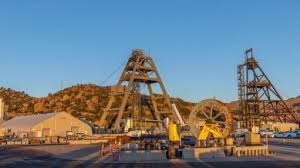
Washington's efforts to increase output of lithium, nickel, and other metals for the energy transition are hampered by the fact that it takes an average of roughly 29 years to establish a new mine in the United States, the second-longest in the world after only Zambia, according to a report released on Thursday.
The S&P Global consultancy report opens in a new tab. This comes amid growing pressure on American officials to expedite the mining permit application process, which some lawmakers and mining companies view as a convoluted and drawn-out process that undermines efforts to counter China's almost complete monopoly on the vital minerals sector.
S&P investigated 268 mining operations worldwide from the time a metal deposit was found until it started to be produced.
According to the research, Zambia, a country rich in copper and cobalt, has the longest development schedule globally, taking about 34 years—five years longer than that of the United States.
The top five longest development durations were completed by Canada, Argentina, and Mongolia, where Rio Tinto developed the Oyu Tolgoi copper mine.
Australia, at twenty years, was the best among nations most similar to the United States, while Ghana, the Democratic Republic of the Congo, and Laos had some of the quickest development durations in the world, at about ten to fifteen years.
The study, which made no policy suggestions, was partially funded by the National Mining Association, a trade association representing the American mining sector. The NMA "did not provide data or substantive input," according to S&P Global.
According to Reuters last month, the NMA is spearheading an effort to persuade Washington to resurrect the long-dormant U.S. Bureau of Mines. Mining offices at the federal level exist in both Australia and Canada, according to the S&P assessment.
The analysis projected that both the Resolution Copper project by Rio and BHP in Arizona and the Pebble copper and gold project by Northern Dynasty in Alaska, which are both prohibited, would open by 2030. There has been resistance to both projects from Indigenous peoples and environmental groups, which the study did not provide strategies to address.
The potential impact on U.S. copper output from additional leaching operations, which do not require new permits, such as those carried out by Freeport-McMoRan and others, was not covered in the paper.
According to the paper, a high incidence of litigation against U.S. mining projects has lowered exploration budgets; in the last 15 years, businesses with projects in Australia and Canada have spent 81% and 57% more, respectively, to identify new resources than those in the U.S.
According to S&P statistics, the United States possesses over double the reserves and resources of those other nations in terms of copper and lithium.
According to the 28-page analysis, which opens in a new tab, nickel mines develop at the slowest rate globally, taking an average of 17.5 years, while gold mines develop at the quickest rate, taking an average of 15.2 years.
(Source:www.reuters.com)
The S&P Global consultancy report opens in a new tab. This comes amid growing pressure on American officials to expedite the mining permit application process, which some lawmakers and mining companies view as a convoluted and drawn-out process that undermines efforts to counter China's almost complete monopoly on the vital minerals sector.
S&P investigated 268 mining operations worldwide from the time a metal deposit was found until it started to be produced.
According to the research, Zambia, a country rich in copper and cobalt, has the longest development schedule globally, taking about 34 years—five years longer than that of the United States.
The top five longest development durations were completed by Canada, Argentina, and Mongolia, where Rio Tinto developed the Oyu Tolgoi copper mine.
Australia, at twenty years, was the best among nations most similar to the United States, while Ghana, the Democratic Republic of the Congo, and Laos had some of the quickest development durations in the world, at about ten to fifteen years.
The study, which made no policy suggestions, was partially funded by the National Mining Association, a trade association representing the American mining sector. The NMA "did not provide data or substantive input," according to S&P Global.
According to Reuters last month, the NMA is spearheading an effort to persuade Washington to resurrect the long-dormant U.S. Bureau of Mines. Mining offices at the federal level exist in both Australia and Canada, according to the S&P assessment.
The analysis projected that both the Resolution Copper project by Rio and BHP in Arizona and the Pebble copper and gold project by Northern Dynasty in Alaska, which are both prohibited, would open by 2030. There has been resistance to both projects from Indigenous peoples and environmental groups, which the study did not provide strategies to address.
The potential impact on U.S. copper output from additional leaching operations, which do not require new permits, such as those carried out by Freeport-McMoRan and others, was not covered in the paper.
According to the paper, a high incidence of litigation against U.S. mining projects has lowered exploration budgets; in the last 15 years, businesses with projects in Australia and Canada have spent 81% and 57% more, respectively, to identify new resources than those in the U.S.
According to S&P statistics, the United States possesses over double the reserves and resources of those other nations in terms of copper and lithium.
According to the 28-page analysis, which opens in a new tab, nickel mines develop at the slowest rate globally, taking an average of 17.5 years, while gold mines develop at the quickest rate, taking an average of 15.2 years.
(Source:www.reuters.com)














